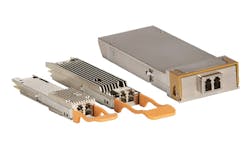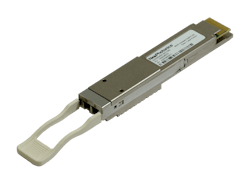After attracting significant industry attention during their standards-setting and development phases, coherent 400-Gbps pluggable optics should finally become generally available in the second half of this year. The expectation is that such modules will come from a wide variety of sources, including systems houses. But will consumption match expectation – or, more bluntly, will there be enough demand to satisfy all of the companies who plan on making them available? Predictions vary, but it’s clear the wait to find out will soon be over.
Where to Start
When OIF began work on the 400ZR Implementation Agreement in 2016, data center interconnect was seen as the primary application. Microsoft had validated the concept of plugging transceivers into routers as a way of streamlining router-to-router interconnect, and the belief was that other hyperscalers would adopt the approach at 400G. With the Implementation Agreement published in 2020 and 400ZR and ZR+ (modules that exceed the 120-km transmission reach specified by OIF) transceivers creeping toward general availability, will demand make the devices the dominant data center interconnect option?
Jimmy Yu, vice president and leader of the optical transport and microwave transmission market research at Dell’Oro Group, also foresees big things for 400ZR/ZR+ in the data center space. But he also expects, as Kozlov implied, that 400G coherent modules will find their way into applications other than data center interconnect. “We do expect, and we’ve already seen announcements by Telia and Windstream, that they are going to start using 400ZR/ZR+. So we are already going to see it in telecom networks. I’m sure MSOs will also use it. So my expectation is that it’s actually going to be a fairly wide use case,” Yu said during the same event. “However, near term, I’d say the volumes are going to be data center interconnect and over time, as the traditional service providers and MSOs adjust their architecture and figure out where their best positions are to use it, they’ll also incorporate it into their networks.”
Brad Booth, principal hardware engineer in Microsoft’s Azure Hardware and Architecture Group, confirmed his company is ready to transition from 100G coherent pluggables to 400G as part of an overall intra- and inter-data center network upgrade to the higher transmission rate. “That transition we’re hoping to start this year, to start moving into the 400-gig ZR realm of deployment,” he commented. “The nice thing for us is we’re not looking to have to completely rip and replace everything we did at 100 gig. We built the 100 gig with the concept that we would want to upgrade that. And so the way we’ve done the system is, hopefully it’s just a step and repeat – you know, just put in new equipment at each end and the rest of the infrastructure in between stays the same.”
Where Will You Get Them?
The number of optical transceiver vendors positioning themselves to participate in this market is extensive. Kozlov cites such companies as Acacia Communications, (now part of Cisco), Inphi (now part of Marvell), NeoPhotonics, and Fujitsu among the early players, with module suppliers such as II-VI, Innolight, and Lumentum as part of a second wave. However, he also expects at least a few system houses to jump into the game. Ciena and Cisco (via Acacia) are two obvious candidates. Meanwhile, he reports that Nokia likely will develop 400ZR devices for its own use. That’s a lot of competition, which Kozlov says may drive product development strategies. “Some of the suppliers actually even chose not to play in ZR. They’re going with ZR+ just to keep the profitability a bit higher,” he stated.
What’s Next?
Having finished the 400ZR Implementation Agreement, OIF has now launched work toward an 800G Coherent Implementation Agreement. Interestingly, Booth didn’t immediately endorse the idea, which appears to have been sparked by Google. “Right now, we’re just monitoring the development going on,” he said. “Right now, we’re not looking at 800 gig as mass deployment inside our data centers yet. We’re ingesting 400 gig. 800-gig modules which are 2x400G, we will take those inside. But, making the actual MAC-to-MAC data rate 800 gig, that’s still under investigation as to when we might do that.”
Nevertheless, it seems that if 400ZR and such variants at Open ZR+ and Open ROADM gain the traction anticipated, 800G pluggable optics can’t be too far behind.
Stephen Hardy is editorial director of Lightwave.
About the Author

Stephen Hardy
Editorial Director and Associate Publisher, Lightwave
Stephen Hardy is editorial director and associate publisher of Lightwave and Broadband Technology Report, part of the Lighting & Technology Group at Endeavor Business Media. Stephen is responsible for establishing and executing editorial strategy across the both brands’ websites, email newsletters, events, and other information products. He has covered the fiber-optics space for more than 20 years, and communications and technology for more than 35 years. During his tenure, Lightwave has received awards from Folio: and the American Society of Business Press Editors (ASBPE) for editorial excellence. Prior to joining Lightwave in 1997, Stephen worked for Telecommunications magazine and the Journal of Electronic Defense.
Stephen has moderated panels at numerous events, including the Optica Executive Forum, ECOC, and SCTE Cable-Tec Expo. He also is program director for the Lightwave Innovation Reviews and the Diamond Technology Reviews.
He has written numerous articles in all aspects of optical communications and fiber-optic networks, including fiber to the home (FTTH), PON, optical components, DWDM, fiber cables, packet optical transport, optical transceivers, lasers, fiber optic testing, and more.
You can connect with Stephen on LinkedIn as well as Twitter.

